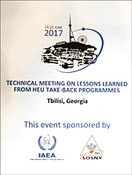M. Budu, S. Komarov (SOSNY R&D Company), S. Moses (Idaho National Laboratory, USA)
The 11th Technical Meeting on Lessons Learned from High Enriched Uranium Take-back Programmes, Tbilisi, Georgia, 19–22 June 2017
TUK-145/C package was created by Russian specialists at US DOE request in the framework of RRRFR Programme to ship radioactive materials with no activity limit (especially research reactor spent fuel) by air in compliance with the IAEA requirements for type C packages. Since 2011 certificates of approval for this package design were issued for shipments of HEU research reactor fuel from Viet Nam, Hungary, Uzbekistan to the Russian Federation, and HEU MNSR fuel from Ghana to People’s Republic of China. Different activities and characteristics of the radioactive content dictated the need to develop new canisters and baskets for use in the TUK-145/C, to classify and certify the package as type B(U) or C and consequently to develop different safety assessment reports to demonstrate the compliance to the IAEA requirements. This paper presents an analysis of different tasks and solutions addressed in Russian safety assessment reports, as well as questions raised by involved countries’ Competent Authorities and lessons learned from TUK-145/C licensing.






